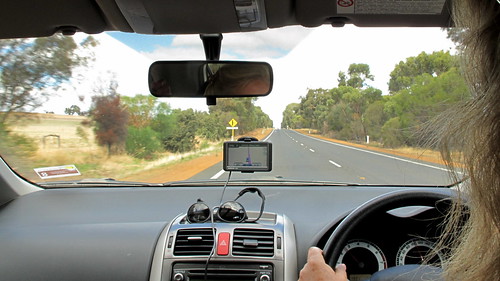One of our first purchases in Australia was a Garmin GPS.
We have one in Canada, and use it all the time—even for roads we know—so there was never any doubt that we would get one for Australia.
 The wider screen on this newer model—a nuvi 265W—shows more of the map at once. Our old model—named “Penny” because of her very British voice—spoke the directions but not the names of streets. This model—not yet named, but currently set to the Australian voice “Serena”—manages to speak not just the street names, but even words we key in as destination names.
The wider screen on this newer model—a nuvi 265W—shows more of the map at once. Our old model—named “Penny” because of her very British voice—spoke the directions but not the names of streets. This model—not yet named, but currently set to the Australian voice “Serena”—manages to speak not just the street names, but even words we key in as destination names.
A new feature I really appreciate is the ability to save tracks. As we drive, the GPS records the time and location as a series of points, and I can upload these later to our computer. The track can then be viewed as an overlay in Google Earth, so we can see where we’ve been. As well, because both the GPS and our cameras record the time and date, I can use my RoboGeo software to add latitude and longitude to our digital pictures.
The biggest advantage of a GPS is that it takes the edge off of navigating. We always have a map with us, and usually plan our route to some extent, but having a GPS lets us enjoy the scenery rather than watching for our route. It reports the distance to the next turn, and a small icon gives a visual cue to prepare the driver for the type of turn.
We bought “Penny” in England and appreciated how it eased the adjustment to right-hand drive. The same is true here in Australia: a spoken instruction like “At the roundabout, take the third exit to Strickland Street” provides much more useful information than seeing on a map that we need to turn right.
When we return to Canada, I’ll acquire current mapping information for North America, so the same unit will continue to serve us. For me, a GPS has become an indispensible driving tool.
